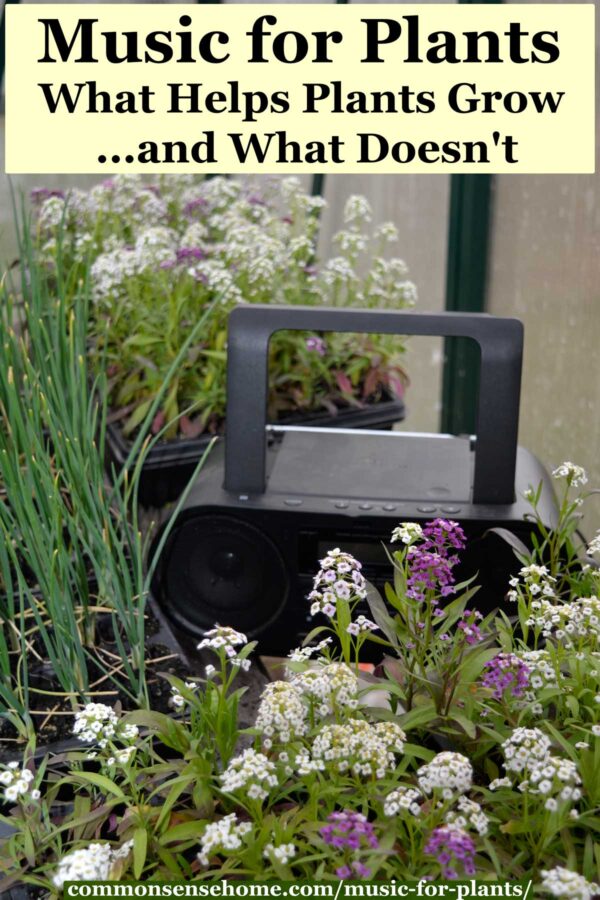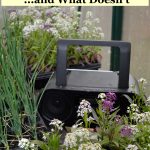Music for Plants – What Helps Plants Grow and What Doesn’t
We know plants don’t have ears, so how can playing music for plants help them grow? It’s all about the vibration. We’ll share what music works best for plant growth based on studies and experiments in our own garden.

Plant Music? Really?
When reading The Secret Life of Plants, I discovered Sonic Bloom – musical sounds designed to boost plant growth. The creator of Sonic Bloom discovered that specific sound frequencies mimic the dawn chorus of bird song. These frequencies encourage the plants to open their leaf stomata, boosting their intake of morning dew – and gentle organic foliar fertilizers.
I exposed plants to music in my greenhouse, and it turned into a jungle. The tomato plants grew all the way up the trellis and across the roof. When starting seedlings and sprouting grains for the ducks and chickens, plants exposed to music show more vigorous growth.
Effects on plants include:
- Faster growth
- Earlier blooms
- Increased yields
- Improved nutrition
- Reduced pest pressure
How Does it Work?
The jury is still out on this, but we seem to have at least three different types of stimulation.
- Plain vibration and music with a stronger beat may mimic wind and other plant stressors, telling the plant that it needs to bulk up.
- Gentler music with a higher pitch that’s more similar to bird song encourages stomata dilation, boosting nutrient intake so plants grow faster.
- Other research suggests boosts in sap flow and plant hormones
Experimental results include:
- Tomatoes 2.5 times larger with a sweeter flavor
- Vegetable yield increased by 40%
- Reduction in tomato mosaic virus
- Faster time to maturity, with fruits, vegetables and flower ready 1-3 weeks early
- Improved frost resistance
- Better germination rates
- Fruit size of edible mushrooms increased by 43.3%
- Longer lasting and more abundant flowers

Which Music for Plants Works Best?
There’s some debate on this, so I encourage you to try different music that you enjoy.
Mythbusters found that plants grew better with noise than without noise, whether it was talking or different genres of music.
The Sonic Bloom CDs combine classical and bird song (along with some bizarre elevator style music from the 70s). Other experiments used sounds like traffic noise and vedic chants.
To open stomata, classical stringed instruments, Indian classical, ragas and Vedic music are some of the best choices.
Recommended classical composers include:
Would you like to save this?
- Vivaldi
- Hayden
- Beethoven
- Brahms
- Schubert
- Mozart
- Mahler
- Bach
From “The Sound of Music and Plants”:
- Plants prefer stringed instruments
- Classical music, including Indian classical music, ragas and Vedic music encourages lush growth
- Heavy metal, New Age and Celtic music increase plant mass and fruit taste
- Jazz also increases growth
Play stringed music in early morning, when the dew is still on the leaves. (This mimics the dawn chorus of the birds). You may play music for several hours a day, but finish by around 10 am to allow the plants to close their stomata during the heat of midday.
If you want to apply foliar fertilizer while playing music, start the sound 30 minutes before fertilizing and stop it 2 hours after. Don’t feed plants more than once per week.
What Sounds are Best to Avoid
Not all experiments found the same results, so again, I encourage you to experiment.
I think bass is fine in some cases, but I wouldn’t have noise going day and night. Plants need to rest, too.
- Too much bass damages plants (some types of rap, noisy rock music)
- Plants are indifferent to country music (Your results may vary. There are many forms of country nowadays.)
- Continuous noise can kill plants
- Plants respond negatively to harsh language and emotions (pain and anger).
Recorded bad language doesn’t seem to cause a problem, according to Mythbusters. Maybe the plants know the difference?
Have you tried Playing Music for Plants?
Have you tried playing music for your plants? Maybe you talk to your plants? If so, what results have you seen? What kind of music do you use?
We’ve seen good results with classical, but haven’t tried control groups with other genres.
More Gardening Tips
We have over 100 gardening articles on the site, all neatly sorted by category on the Common Sense Gardening page. They include:
- Free Gardening Journal Templates and Other Garden Record Keeping Tips
- Organic Fertilizer – Feed Your Plants, Soil and Microbes
- The Ultimate Guide to Natural Pest Control in the Garden
Topic areas include getting started, seeds starting, vegetables, fruits, herbs, vertical gardening, gardening tools and equipment, pest control, permaculture, season extension, crop storage, preserving the harvest and more. We’re here to help you with all your gardening questions.
Sources
- Effect of sound on plant growth
- MythBusters Episode 23: Exploding House
- Effect of Music on Plants – An Overview
- The Effect of Music on Plant Growth and Pests
- Effect of Sound on the Growth of Plant: Plants Pick Up the Vibrations


any chance this would help a tree? my beloved large locust tree was struck by lightning last summer. it looked a bit sickly this summer. I’ll do anything to save it. please help!
I don’t know how much it might help, but at the very least it shouldn’t hurt. Lightning damage is really hard on trees, but some survive.
If you don’t think it’s too strange to try, spend more time near the tree and tell it how much you care about it. Plants can sense things, they just react differently than we do. I’ve noticed that wild plants often show up randomly in my yard when I have a particular need for them. It’s all a little weird, but I roll with it.
I’m going to try Terry Riley based on this. So far they’ve had a little Pink Floyd, which some of their ancestors may have inspired. I’m surprised to hear metal works.
Hi ,
I’m very interested in this research “MUSIC FOR PLANTS”, could you please let me know the efficient music volume level when I playing for plants?
Thanks!
Brian
Most of the materials don’t talk about specific decibel levels, but one does mention, “They reported significant reduction of germination time and increase in growth of the seedlings when exposed to frequency of 2000 Hz and intensity of 90 dB.”
I found a French almost like jazz lounge playlist on Spotify. I ended up having an enormous crop of Green beans and Tomatoes.
Currently playing Vangelis to my sarrecenia and Venus flytrap.
(Too early to tell any results.)